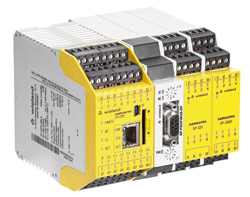
Posted to News on 18th Jun 2018, 10:16
The benefits of modular, configurable safety controls
Kevan Cowley of Wieland Electric explains the key features that should be considered in order to maximise the benefits when using modular safety systems.

There has been growing recognition in the last few years of the benefits of modular, configurable safety controls. Not least of these is the ability of a modular safety system to reduce the complexity of the wiring, compared to using standalone safety relays that need to interact with each other and can require very complex wiring, which often extends design time, installation and commissioning.
Modular, configurable safety control systems use centralised input/output (I/O) systems that reduce the hard wiring requirement and therefore the overall complexity. However, the complexity of the wiring can vary considerably between different types of modular safety system.
Which type of modular safety system?
There are two types of modular solution currently available: mechanically configurable systems and software-based safety circuits. Mechanically configurable options tend to have more complex wiring, so a software system that uses a centralised I/O will be the preferred option in the majority of situations.
However, there is also variation in the level of complexity between different types of software-based systems, particularly in terms of the complexity of the wiring requirements for monitoring and diagnosing faults.
With some systems there is also a limitation imposed by having a fixed number of I/O or function blocks within the software, so it may then be necessary to pay more for a system where expandable I/O can be beneficial. This can be a particular problem for smaller systems, as it may be necessary to bear the cost of many more I/Os than are required upfront, often making the use of a modular system financially beneficial.
In contrast, some solutions offer the controller separately from the I/O module, which makes it very easy to match the I/O requirement precisely to the requirements of the system.
Network communications

There are also significant benefits helping to comply with EN ISO 13849-2 where full reports and documentation are required and automatically date and time stamped, making it easier to identify the root cause of the fault and ensuring simple yet comprehensive compliance documentation.
When using a software-based system it is essential to include a self-validating verification process, according to EN ISO 13849-2, as this will prevent mistakes being made and ensure compliance with appropriate regulations and negating the need to produce written reports, diagrams and photographs necessary for system verification.
Taking time to research various modular, configurable safety control systems at the beginning of the project will pay dividends in the longer term and ensure all potential financial and performance benefits are achieved.
For more information about modular, configurable safety control systems from Wieland, go to www.wielandsafety.net.
Ash House, Tanshire Park
Shackleford Road
GU8 6LB
UNITED KINGDOM
+44 (0)1483 531213






























